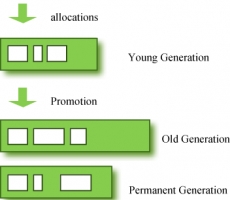-
Read More

A Node.js speed dilemma: AJAX or Socket.IO?
Written by CUBRID Community on 07/14/2017 One of the first things I stumbled upon when I started my first Node.js project was how to handle the communication between the browser (the client) and my middleware (the middleware being a Node.js application using the CUBRID Node.js driver (node-cubrid) to exchange information with a CUBRID 8.4.1 database). I am already familiar with AJAX (btw, thank God for jQuery!!) but, while studying Node.js, I found out about the Socket.IO module and even found some pretty nice code examples on the internet... Examples which were very-very easy to (re)use... So this quickly becomes a dilemma: what to choose, AJAX or sockets.io? Obviously, as my experience was quite limited, first I needed more information from out there... In other words, it was time to do s... -
Read More

Become a Jave GC Expert Series 1 : Understanding Java Garbage Collection
Written by Sangmin Lee on 05/31/2017 What are the benefits of knowing how garbage collection (GC) works in Java? Satisfying the intellectual curiosity as a software engineer would be a valid cause, but also, understanding how GC works can help you write much better Java applications. This is a very personal and subjective opinion of mine, but I believe that a person well versed in GC tends to be a better Java developer. If you are interested in the GC process, that means you have experience in developing applications of certain size. If you have thought carefully about choosing the right GC algorithm, that means you completely understand the features of the application you have developed. Of course, this may not be common standards for a good developer. However, few would object when I say ... -
Read MoreNo Image
Become a Jave GC Expert Series 2 : How to Monitor Java Garbage Collection
Written by Sangmin Lee on 06/01/2017 This is the second article in the series of "Become a Java GC Expert". In the first issue Understanding Java Garbage Collection we have learned about the processes for different GC algorithms, about how GC works, what Young and Old Generation is, what you should know about the 5 types of GC in the new JDK 7, and what the performance implications are for each of these GC types. In this article, I will explain how JVM is actually running Garbage Collection in the real time. What is GC Monitoring? Garbage Collection Monitoring refers to the process of figuring out how JVM is running GC. For example, we can find out: when an object in young has moved to old and by how much, or when stop-the-world has occurred and for how long. GC monitoring is carried out t... -
Read More

Become a Jave GC Expert Series 3 : How to Tune Java Garbage Collection
Written by Sangmin Lee on 06/02/2017 This is the third article in the series of "Become a Java GC Expert". In the first issue Understanding Java Garbage Collection we have learned about the processes for different GC algorithms, about how GC works, what Young and Old Generation is, what you should know about the 5 types of GC in the new JDK 7, and what the performance implications are for each of these GC types. In the second article How to Monitor Java Garbage Collection I have explained how JVM actually runs the Garbage Collection in the real time, how we can monitor GC, and which tools we can use to make this process faster and more effective. In this third article based on real cases as our examples I will show some of the best options you can use for GC tuning. I have written this arti... -
Read More

Become a Jave GC Expert Series 4 : MaxClients in Apache and its effect on Tomcat during Full GC
Written by Dongsoon Choi on 06/23/2017 This is the fourth article in the series of "Become a Java GC Expert". In the first issue Understanding Java Garbage Collection we have learned about the processes for different GC algorithms, about how GC works, what Young and Old Generation is, what you should know about the 5 types of GC in the new JDK 7, and what the performance implications are for each of these GC types. In the second article How to Monitor Java Garbage Collection we have explained how JVM actually runs the Garbage Collection in the real time, how we can monitor GC, and which tools we can use to make this process faster and more effective. In the third article How to Tune Java Garbage Collection we have shown some of the best options based on real cases as our examples that you c...



